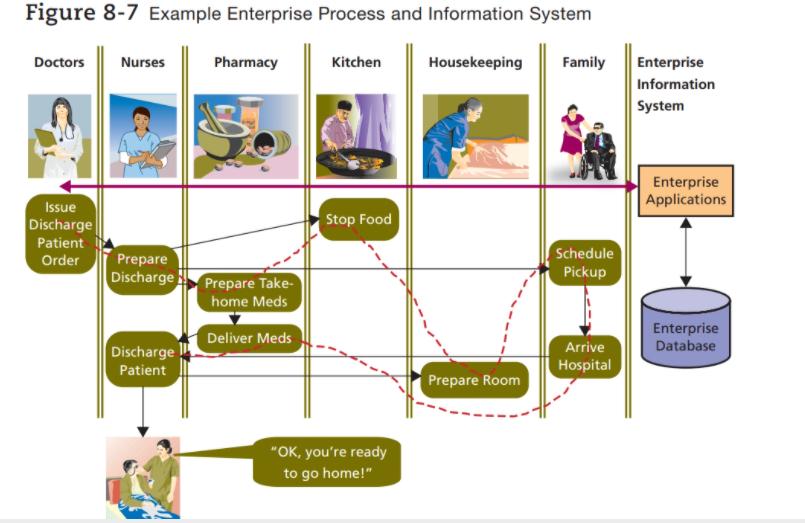The county planning office issues building permits, septic system permits, and county road access permit for all building projects in the county. The planning office
The county planning office issues building permits, septic system permits, and county road access permit for all building projects in the county. The planning office issues permits to homeowners and builders for the construction of new homes and buildings and for any remodeling projects that involve electrical, gas, plumbing, and other utilities, as well as the conversion of unoccupied spaces such as garages into living or working space. The office also issues permits for new or upgraded septic systems and permits to provide driveway entrances to county roads.
Figure 8-14 shows the permit process that the county used for many years. Contractors and homeowners found this process to be slow and very frustrating. For one, they did not like its sequential nature. Only after a permit had been approved or rejected by the engineering review process would they find out that a health or highway review was also needed. Because each of these reviews could take 3 or 4 weeks, applicants requesting permits wanted the review processes to be concurrent rather than serial. Also, both the permit applicants and county personnel were frustrated because they never knew where a particular application was in the permit process. A contractor would call to ask how much longer, and it might take an hour or more just to find which desk the permits were on.
Accordingly, the county changed the permit process to that shown in Figure 8-15. In this second process, the permit office made three copies of the permit and distributed one to each department. The departments reviewed the permits in parallel; a clerk would analyze the results and, if there were no rejections, approve the permit.
Unfortunately, this process had several problems, too. For one, some of the permit applications were lengthy; some included as many as 40 to 50 pages of large architectural drawings. The labor and copy expense to the county was considerable.
Second, in some cases departments reviewed documents unnecessarily. If, for example, the highway department rejected an application, then neither the engineering nor health departments needed to continue their reviews. At first, the county responded to this problem by having the clerk who analyzed results cancel the reviews of other departments when he or she received a rejection. However, that policy was exceedingly unpopular with the permit applicants because once an application was rejected and the problem corrected, the permit had to go back through the other departments. The permit would go to the end of the line and work its way back into the departments from which it had been pulled. Sometimes this resulted in a delay of 5 or 6 weeks.
Canceling reviews was unpopular with the departments as well because permit-review work had to be repeated. An application might have been nearly completed when it was canceled due to rejection in another department. When the application came through again, the partial work results from the earlier review were lost.
Figure 8-14 (Above)

Figure 8-15 (Above)

1. Explain why the processes in Figures 8-14 and 8-15 are classified as enterprise processes rather than as departmental processes. Why are these processes not considered to be inter-enterprise processes?
2. Using Figure 8-7 as an example, redraw Figure 8-14 using an enterprise information system that processes a shared database. Explain the advantages of this system over the paper-based system in Figure 8-14.
3. Using Figure 8-7 as an example, redraw Figure 8-15 using an enterprise information system that processes a shared database. Explain the advantages of this system over the paper-based system in Figure 8-15.
4. Assuming that the county has just changed from the system in Figure 8-14 to the one in Figure 8-15, which of your answers in questions 2 and 3 do you think is better? Justify your answer.
5. Assume your team is in charge of the implementation of the system you recommend in your answer to question 4. Describe how each of the five challenges, collaborative management, requirement gaps, transition problems, employee resistance, and new technology, pertain to this implementation. Explain how your team will deal with those challenges.
Make Permit Copies Receive Permit Application Engineering opy Highway Department py Health Department y Engineering Review Health Department Review Highway Department Review Approved or Rejected Permit Approved or Rejected Permit Approved or Rejected Permit Analyze Results Approved? No Yes Reject Permit Approve Permit
Step by Step Solution
3.56 Rating (153 Votes )
There are 3 Steps involved in it
Step: 1
Question one 814 and 815 are enterprise process this because they support different activities in di...
See step-by-step solutions with expert insights and AI powered tools for academic success
Step: 2

Step: 3

Ace Your Homework with AI
Get the answers you need in no time with our AI-driven, step-by-step assistance
Get Started


